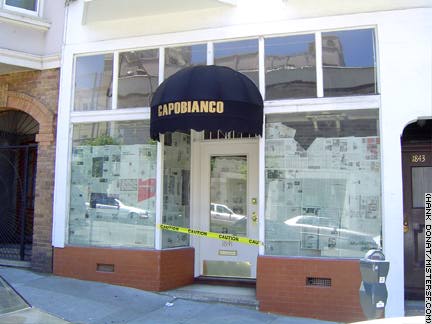| |
|
Dude where's my City? In mid-May, 2004, Lori Haigh decided to give up her North Beach art gallery after facing death threats for displaying a painting depicting the abuse of Iraqi prisoners by American soldiers. When a single mother of two, an independent businesswoman, is terrorized out of her storefront for showing an art work, San Francisco is not San Francisco. It was already over for Haigh by the time neighbors and supporters were discussing a plan to display "The Abuse" by Guy Colwell in a prominent place in defiance of those who allegedly assaulted Haigh, threatened her and her family, and vandalized her Capobianco gallery. It's a pity that the cowards won by intimidating this lady with their rage. It should be directed at people like George W. Bush who create shameful realities, not paintings of them. The Abu Ghraib prison scandal proves what peace activists have always said about the ripple effect of violent and non-violent reactions to problems in the world. Regardless of your position on the Iraq War, the affair of Capobianco took a turn for the absurd when neighbors staged a rally in front of the gallery on Saturday morning, May 29. Attendees of the "Rally in Support of Freedom of Expression" found a U-Haul in front of the gallery. Haigh was in the locked gallery with only KRK Ryden, the artist whose exhibit was to have followed Colwell's at the gallery. Shortly before 10 a.m., a man who introduced himself as a successful litigant in a 1983 flag burning case arrived and met Haigh for the first time after speaking with her on the telephone earlier in the week. At that time, Ryden said he still wasn't sure if his exhibit was going to happen on June 5. Neighbors began showing up in twos and threes. The flag burner allowed a handful of reporters and photographers to enter the gallery. The gallery is one small room. Acting as her spokesperson, the man said that Haigh wouldn't be making any statement to the press or to the gathering crowd. Only a few feet away, Haigh was on the telephone. She was agitated. She had clearly been bashed in the face. She was wearing her arm in a sling due to a recent surgery, she later said. After photographing the Abuse painting and speaking with Ryden and the flag burner, the media were restless. The reporters and gathering crowd still expected the rally would be just that, folks raising their voices in support for the victim and in defiance of the opposition. It is how some would later report it, citing the presence of community leaders while neighbors strategized outside the gallery. Except in this Bizarro version of San Francisco, that's not how it was at all. With Haigh on the telephone repeating, "It's over for me as of now. It's done," in the presence of reporters, her spokesperson was still insisting she wouldn't be commenting. A man played a guitar outside. When Haigh put down the phone, she readily addressed the reporters and allowed herself to be photographed. She answered some questions about the alleged apathy of the police and offered to play threatening voicemail messages. The reporters declined to hear them, presumably because no one wished to further upset the harried art dealer. She said that she was stressed because Colwell was late and if she didn't get the U-Haul back by 2:00 she would incur charges. One well-known TV reporter offered to leave. With reporters beginning to give up such expectations as prepared remarks and a programmed rally, Colwell suddenly arrives. "No pictures!" he says. Colwell, who served time in prison as a conscientious objector during the Vietnam War, seemed stunned when his request was ignored by the throng of reporters. It was his lesson in freedom of the press. Colwell commented only to chastise the media and to rebuff stunned neighbors' requests for photos and offers of solace. What started as a rally for supporters of freedom of expression had become an odd mob of confused art lovers trying to offer encouragement to someone who was either freaked out or indifferent. The artist, inexplicably angry at a generally sympathetic media, scorned supporters entirely. Community leaders were conspicuously absent. A hundred or more people showed up but no one representing the City nor an attorney nor anyone from any organized arts group, free speech group, nor law enforcement agency. Basically, the rally consisted of Haigh and Colwell ditching the gallery while everyone tried not to get in their way. A sullen Colwell loaded his art. When he finished, Haigh reemerged from the gallery. She was greeted by cheers on the sidewalk. As neighbors and friends and people from the community called out their love and support, Haigh's face was mostly expressionless. She got in the U-Haul and drove away with Colwell in the passenger's seat. In their wake, a local poet read a verse and even that was inappropriate and seemed upside down. It contained a note of vengence. Jack Hirschman spoke of "the proverbial thumb in the eye." And that was the end of a strange chapter in a North Beach story, dateline San Francisco, or some reasonable facsimile, perhaps in another dimension. "Heart of the City" was the first media outlet to go on the record with a source close to the investigation who concluded that the Capobianco episode was more than likely a publicity stunt that got out of control. (Heart of the City 06/07/04.) View Mister SF's fascinating photo series on the free speech rally that wasn't! |
|
Copyright 2004 Hank Donat |
